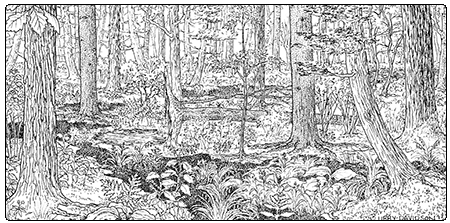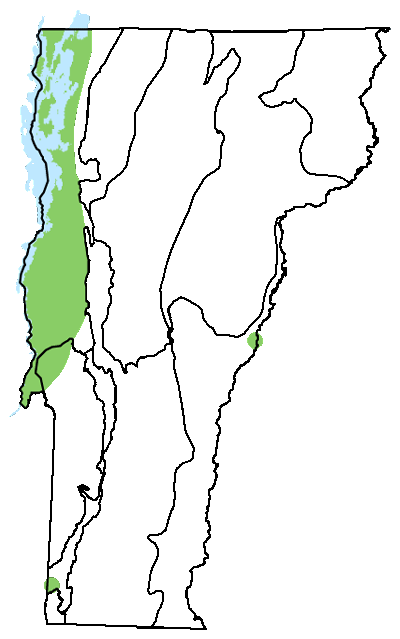Ecology and Physical Setting
Wet Clayplain Forests most commonly occur as small wetland patches within surrounding, larger areas of Mesic Clayplain Forest. On these level clay-soil plains, a few inches to a foot of elevation makes a big difference. In low areas, water accumulates and wetland conditions develop, whereas in slightly higher areas, there is adequate drainage to support upland communities. These forests also occur on low-lying, broad clay flats where drainage is slow and wet conditions persist. Often these larger patches are surrounded by upland clay soils that at one time supported Mesic Clayplain Forests. The forests on these drier soils were cleared for agriculture, while the Wet Clayplain Forests were too wet to bother with.
 Wet Clayplain Forests typically occur on poorly-drained clays, including Covington, Panton, Kingsbury, and Livingston soils. These soils hold water for a long time in the spring but may become quite dry during droughty summer months. When these wetland forests occur as mosaics with Mesic Clayplain Forests, they are difficult to map separately due to the fine scale at which these communities intermingle.
Wet Clayplain Forests typically occur on poorly-drained clays, including Covington, Panton, Kingsbury, and Livingston soils. These soils hold water for a long time in the spring but may become quite dry during droughty summer months. When these wetland forests occur as mosaics with Mesic Clayplain Forests, they are difficult to map separately due to the fine scale at which these communities intermingle.
Wet Clayplain Forest is one of the natural communities of the Champlain Valley clayplain forest ecosystem, which is described under the Mesic Clayplain Forest natural community.
Vegetation
Wet Clayplain Forests are dominated by wetland species, but unlike most other wetland forests and swamps, They also support some upland species, albeit in low abundance. This likely reflects the seasonally dry soils of many Wet Clayplain Forests, in contrast to swamps with permanently saturated soils. Buttressed trunks and raised, shallow roots characterize trees in Wet Clayplain Forests.
Wet Clayplain Forests have the most diverse assemblages of tree species of any swamp or wet forest in Vermont. Green ash, swamp white oak, black ash, bur oak, American elm, and red maple dominate their closed canopies. Common wetland and upland canopy associates include white oak, white ash, hemlock, white pine, yellow birch, shagbark hickory, northern white cedar, and silver maple. Musclewood is a common understory tree.
The often dense tall shrub layer includes winterberry holly, arrowwood, and highbush blueberry. Herbs are mostly wetland species, and cover and composition can vary from site to site. Common species include sensitive fern, interrupted fern, cinnamon fern, wood nettle, royal fern, dwarf raspberry, northern bugleweed, hog peanut, foamflower, brome-like sedge, hop sedge, and Tuckerman’s sedge. In some of the wettest forests, lake sedge may be dominant.
Wildlife Habitat
The remnants of the clayplain forest ecosystem in the fragmented Champlain Valley are critically important for many species of wildlife. The wildlife habitat provided by any patch of Wet Clayplain Forest is shaped by the forest itself and by the surrounding Mesic Clayplain Forest and other communities. Larger and deeper depressions in Wet Clayplain Forests may hold water long enough to provide breeding habitat for spotted salamanders, wood frogs, and blue-spotted salamanders. Gray treefrogs, which breed in open water, may be abundant in these wet woods when marshes with permanent water are nearby. Breeding birds include veery, winter wren, and the rare blue-gray gnatcatcher. Shagbark hickory, which can be locally abundant in Wet Clayplain Forests, provides habitat for two notable species. Caterpillars of the uncommon hickory hairstreak butterfly rely on hickory as their primary food source. The globally rare Indiana bat roosts under the shedding, platy bark.
Related Communities
- Mesic Clayplain Forest occurs on moderately well-drained clay soils (typically Vergennes soils) and is dominated by upland tree species, primarily red oak, white oak, shagbark hickory, sugar maple, and white ash. These two communities commonly form a patchy mosaic.
- Wet Sand-Over-Clay Forest is also a wetland community of the clayplain forest ecosystem. It occurs on poorly drained soils with wet sand overlying clay or silt. The sandy overburden creates a more acidic, nutrient-poor environment. Red maple, green ash, and swamp white oak dominate.
Conservation Status and Management Considerations
This rare, small patch wetland natural community now occupies a fraction of its distribution before European settlement. It is a characteristic community of the Champlain Valley, and it hosts an unusual assemblage of plants and animals. There are several good examples on conserved lands, but it is important to protect other examples, and to restore and maintain the natural ecological processes and species composition. Connections between these patches of forest are critical for wildlife movement and the long-term viability of the clayplain forest ecosystem.
Distribution/Abundance
In Vermont, this rare natural community is almost entirely restricted to the Champlain Valley. Isolated examples have been documented in the Southern Vermont Piedmont and Vermont Valley. Closely related communities occur in the lower Great Lakes region.
Characteristic Plants
Trees
Abundant Species
Green ash – Fraxinus pennsylvanica
Swamp white oak – Quercus bicolor
Black ash – Fraxinus nigra
Bur oak – Quercus macrocarpa
American elm – Ulmus americana
Red maple – Acer rubrum
Occasional to Locally Abundant Species
White oak – Quercus alba
White ash – Fraxinus americana
Eastern hemlock – Tsuga canadensis
Red oak – Quercus rubra
White pine – Pinus strobus
Yellow birch – Betula alleghaniensis
Shagbark hickory – Carya ovata
Musclewood – Carpinus caroliniana
Northern white cedar – Thuja occidentalis
Basswood – Tilia americana
Silver maple – Acer saccharinum
Shrubs
Winterberry holly – Ilex verticillata
Arrowwood – Viburnum dentatum
Highbush blueberry – Vaccinium corymbosum
Silky dogwood – Cornus amomum
Herbs
Sensitive fern – Onoclea sensibilis
Hog peanut – Ampicarpaea bracteata
Foamflower – Tiarella cordifolia
Interrupted fern – Osmunda claytoniana
Wood nettle – Laportea canadensis
Royal fern – Osmunda regalis
Cinnamon fern – Osmundastrum cinnamomeum
Dwarf raspberry – Rubus pubescens
Northern bugleweed – Lycopus uniflorus
Jack-in-the-pulpit – Arisaema triphyllum
Common jewelweed – Impatiens capensis
Lake sedge – Carex lacustris
Brome-like sedge – Carex bromoides
Hop sedge – Carex lupulina
Tuckerman’s sedge – Carex tuckermanii
Lady fern – Athyrium filix-femina
Bladder sedge – Carex intumescens
False nettle – Boehmeria cylindrica
Crested wood fern – Dryopteris cristata
Marsh fern – Thelypteris palustris
Whitegrass – Leersia virginica
Stout woodreed – Cinna arundinacea
Rough avens – Geum laciniatum
Slender mannagrass – Glyceria melicaria
Skunk cabbage – Symplocarpus foetidus
Bailey’s sedge – Carex baileyi
Bryophytes
Tree moss – Climacium dendroides
Common fern moss – Thuidium delicatulum
Moss – Calliergon cordifolium
Three-lobed bazzania – Bazzania trilobata
Rare and Uncommon Plants
Green dragon – Arisaema dracontium
Buxbaum’s sedge – Carex buxbaumii
False hop sedge – Carex lupuliformis
American hazelnut – Corylus americana
Gray’s sedge – Carex grayi
Virginia bugleweed – Lycopus virginicus
Cattail sedge – Carex typhina
Associated Animals
Spotted salamander – Ambystoma maculatum
Wood frog – Lithobates sylvaticus
Gray treefrog – Hyla versicolor
Winter wren – Troglodytes hiemalis
Veery – Catharus fuscescens
Great crested flycatcher – Myiarchus crinitus
Rare and Uncommon Animals
Blue-spotted salamander – Ambystoma laterale
Indiana bat – Myotis sodalis
Red-shouldered hawk – Buteo lineatus
Blue-gray gnatcatcher – Polioptila caerulea
Hickory hairstreak – Satyrium caryaevorus
Places to Visit
Round Pond State Park, South Hero, Vermont Department of Forests, Parks, and Recreation
LaPlatte River Marsh Natural Area, Shelburne, The Nature Conservancy
Dead Creek Wildlife Management Area, Addison, Vermont Fish and Wildlife Department
Shellhouse Mountain, Ferrisburgh Municipal Forest
